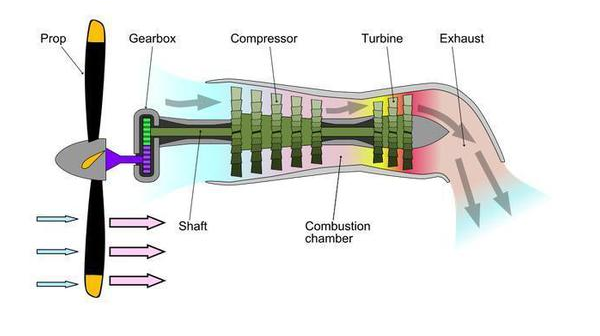Today, when China's aerospace science and technology continue to make remarkable achievements, we still need to see our shortcomings. For all kinds of aircraft, what has plagued Chinese people for many years is the problem of aviation development. It is always difficult to develop high-performance engines that is our heart disease. The speed, take-off and maneuvering of airplanes all have relatively high technical requirements for airplane engines, so it is absolutely correct to call the engine the heart of the airplane. Although our country cannot catch up with Western countries in engine technology for the time being, and has not achieved the same exciting achievements, we are gradually seeing the end of the tunnel, and victory is in sight. Compared with the endless variety of aircraft in our country, the engines that should have taken the lead are much inferior. Aircraft engines are generally divided into turbofan engines, turboshaft engines and turboprop engines, and what we often hear is turbofan engines. For example, the turbofan-10 used by the J-20 fighter and the turbofan-20 used by the Y-20 large transport aircraft.
The reason why everyone is more familiar with turbofan engines has a lot to do with different national priorities. Fighters are the country's most important weapon. Without fighters, there is no air superiority. Therefore, the research and development of fighter engines is naturally given priority. Fighters use turbofan engines. Helicopters use turboshaft engines. In recent years, with the country’s tilt in the development of various armed helicopters, turboshaft engines have also made some breakthroughs. Compared with turbofan engines and turboshaft engines, turboprop engines are currently the blankest project in the field of aeroengines in my country, and they are simply the hardest hit area in China's aerospace industry. A turboprop is also a propeller plane, and the propeller can be driven by a turboprop engine or a piston engine. The turboprop is lighter than the piston type, has a higher power, a higher ceiling, and runs smoothly. Therefore, many large transport aircraft use turboprops, like the United States C-130 Hercules transport aircraft. The piston type is usually only used in low-power applications, and the more common ones are civil rescue and disaster relief aircraft, which are relatively small. Compared with jet airplanes, although turboprop airplanes are slow and noisy, they are fuel-efficient and have short take-off and landing distances. They have unique advantages in many occasions. The most representative one is the American C-130 transport aircraft. Because it is a turboprop engine, the flying requirements are particularly low. Even sandy land can be used. As long as the distance is not particularly short, the take-off is not a big problem. In some battlefields where conditions are not so good, this turboprop-driven aircraft solves a big problem.

(Working principle of turboprop engine)
The use of turboprops is very flexible, in addition to our common double-engine and four-engine (four-engine C-130 transport aircraft) installed on the wings, as well as single-engine installed on the nose (small private jets are more common). The propeller not only has the usual pull-in, but also the propeller's propeller behind. If you think that turboprop launching is an old thing, then you are wrong. With the rise of modern drones, turboprops have gained new importance and usefulness (turboprops can be used on drones). Generally, small drones can be driven by pistons or even batteries (this kind of battery-driven drones are still relatively common). Piston-type or even battery-driven, after all, has limited power. Most of the larger drones use turboprops, the most typical of which is the "Predator" series of drones in the United States. Some people say that the jet is faster and the jet has more thrust, indeed. But jets are also more fuel-intensive, and how much fuel can a UAV carry? Insufficient fuel means short range, short mission time, and low speed flight. Therefore, the observing and hitting integrated drones that are particularly pursuing long endurance and long range are still driven by turboprops.
For my country, due to the lack of suitable small and medium-power turboprop engines, it can only be forced to use piston engines with low power and limited performance, which severely limits performance, such as my country's "Rainbow 5" observation and hitting integrated UAV. Compared with the same type of U.S. "Predator" UAV, my country's "Rainbow 5" uses turbocharged piston engine, the power is only the US "Predator" Garrett TPE331 turboprop (the famous American Huo Nivelles Aerospace Group products) half. At the same time, when the wingspans of the two UAVs are similar, the payload of the "Rainbow 5" UAV and the "Predator" ratio have been reduced by 60%. The ceiling of the Rainbow 5 UAV has also been reduced from 15,000 meters to 9,000 meters, which not only limits the ground horizon and increases cruising resistance, but also limits the plateau takeoff performance. In this comparison, the performance of the two almost similar UAVs is not a little worse because of the difference in one engine. Is it true that we don't have a good drone? No, it's just that we don't have a high-performance engine.
The LGF is extremely thin so it can be incorporated into Membrane Switches that can`t exceed a certain thickness (i.e., small, lighter devices) LGF has limited impact on the tactile feel of buttons. LGF can provide even backlighting across large and small areas, including applications where the light remains on while the switch is powered.
Lgf Membrane Switches,Control Panel Lgf Membrane Switches,Lgf Membrane Switches Keypad,Lgf Membrane Key Switch Panel
KEDA MEMBRANE TECHNOLOGY CO., LTD , https://www.kedamembrane.com
